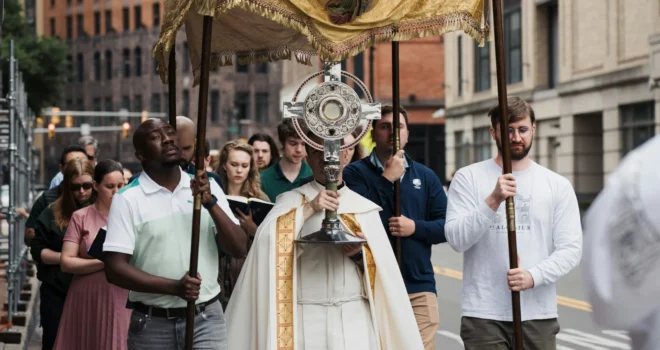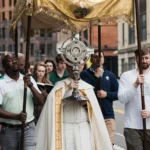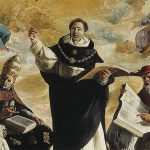Picture a medieval village on the feast of Corpus Christi: cobblestone streets strewn with wildflowers, the air thick with the scent of incense and the sound of chanted hymns. The entire community—peasants, craftsmen, lords—processes behind the Blessed Sacrament, held aloft in a monstrance that glints in the summer sun. This is no mere historical tableau; it is a glimpse into the timeless heart of our Faith, where the Eucharist binds us not only to Christ but to every generation that has knelt before Him.
Today, many Catholics might struggle to name the date of Corpus Christi, yet the Eucharist remains, as the Catechism declares, the “source and summit” of our Christian life. In an age of fragmentation, this sacred continuity calls us back to our roots—a call that Tony Shriner and his team at Mass of the Ages are answering with fervor and vision—and I had the chance to interview him to learn more about their mission.
The Medieval Tapestry: Faith Woven into Daily Life
In the medieval world, faith was not a private affair but a communal heartbeat. During our interview, it was even brought up that the average medieval peasant had a third of the year off for festivals. These were not “vacations” in the modern sense but sacred pauses—days like Candlemas, when candles were blessed to light the dark of winter, or Michaelmas, honoring St. Michael with feasts of goose and prayers for protection. The Assumption of Mary brought processions and mystery plays, transforming villages into living icons of her glory. These celebrations were the frame of a tapestry where the sacred infused every thread of existence.
What did this mean for those communities? It meant a shared identity rooted in the liturgical year, a rhythm that reminded them of their place in the Communion of Saints. The Eucharist was not an abstract doctrine but a tangible presence, carried through the streets, adored in the fields.
Contrast this with our modern landscape: feast days often slip by unnoticed, reduced to a Mass obligation—if that. In our rush toward efficiency and individualism, we’ve lost something vital: the sense of belonging that comes from living faith together. Yet, as Shriner observed, families today can reclaim this heritage: “We’re trying to show the importance of tradition, not just in the liturgy, but tradition as a whole in the feast and festivals, the saints, sacred music, art, architecture, the whole nine yards. Tradition is important.” The domestic church becomes a living echo of those medieval villages, a seedbed for tradition in a secular age.
Mass of the Ages: Guardians of Tradition
As an organization, Mass of the Ages works to reinvigorate those traditions and practices in the daily life of the average Catholic; they are dedicated to preserving the traditional Latin Mass and the broader richness of Catholic heritage. Their work is a bridge between past and present, a testament to the enduring power of tradition. This is not about clinging to the old for its own sake; it’s about recognizing that the ancient liturgy and customs of our Faith carry a depth that speaks to the human soul in ways modernity often cannot. Shriner particularly emphasized the need for Catholics to reclaim their narrative from a culture that often distorts it.
Mass of the Ages is more than a preservation of society—it’s a movement. In a Church sometimes divided by debates over liturgy, their mission offers a unifying vision: the Eucharist as the heartbeat of our worship, expressed through the beauty of the traditional Mass. For those of us who’ve knelt at Adoration, or participated in the sweet silence of the Traditional Latin Mass, there’s an ineffable sense of stepping into eternity, where the prayers of our ancestors mingle with our own. This is the legacy Shriner and his team are fighting to protect.
Projects That Inspire: From Latin Mass to Global Traditions
Mass of the Ages is channeling this vision into three transformative projects, each a beacon of hope for a Church in need of rediscovery:
Latin Mass University: Forming Priests for Eternity
First, there’s Latin Mass University, a program training priests in the traditional rite. The demand for the Latin Mass is surging—parishes report packed pews, young families flocking to the ancient liturgy—yet the supply of trained celebrants lags behind. This initiative bridges that gap, ensuring that the Mass of the Ages remains a living reality. “We still train priests every day through these videos that we’ve made,” Shriner noted, a quiet testament to the program’s reach. In a time when priestly formation can feel standardized, this project honors the uniqueness of liturgical expression, equipping shepherds to lead their flocks back to the wellsprings of tradition.
Discover Tradition: A Global Tapestry of Faith
Next comes Discover Tradition, an episodic series launching in late July. Imagine a Catholic travelogue that sweeps you from the haunting Holy Week processions of southern Spain to the vibrant festivals of Latin America or the quiet devotions of rural Ireland. This isn’t just sightseeing—it’s a celebration of the universal Church’s “Catholic DNA,” as Shriner put it. By showcasing these traditions, the series invites us to marvel at the diversity within our unity, to see how the same faith takes root in countless cultures. “There’s so much wonderful tradition,” Shriner said, dreaming of a series that could run “forever.” For a Catholic audience, this is more than entertainment—it’s a mirror reflecting our own heritage, urging us to cherish and revive it.
Godbread: Eucharistic Saints for a Hungry World
Finally, there’s Godbread, a feature-length film slated for 2026, weaving the stories of three Eucharistic saints. In an era when belief in the Real Presence wavers, this project couldn’t be more timely. “It’s beautiful and amazing,” Shriner said, and he’s right—this is Catholic storytelling at its finest, a cinematic catechesis to rekindle devotion. Amid the U.S. Church’s Eucharistic Revival, Godbread promises to be a spark, igniting hearts with the truth of Christ’s presence.
A New Chapter: Hope Under Pope Leo XIV
This work unfolds against a dramatic backdrop: the election of Pope Leo XIV, the first American pontiff. “I never would have thought in my lifetime that we would see a pope from the United States,” Shriner confessed, echoing the astonishment of many. The sight of him in traditional vestments, tears streaming as he accepted the papacy, stirred something deep. Could this signal a new era for tradition?
He anchored his hope in the new pontiff in a higher truth: “We already have our Savior. Jesus has already won the victory.” An American pope is historic—only the second non-European in over a millennium—but our trust lies not in any man, even a pontiff. The choice of “Leo XIV,” evoking the lionhearted Pope Leo XIII, hints at a reverence for the past, but speculation must yield to prayer. “I’m filled with hope because no matter what happens, the Holy Ghost is at work,” Shriner affirmed. In a Church that has weathered storms for two millennia, this is our bedrock: Christ’s promise that the gates of hell will not prevail.
Embracing Our Heritage: A Call to Action
In a fragmented world, the communal nature of Catholic tradition is a balm. However, the Eucharist, carried through medieval streets or adored in a quiet Mass, binds us across time and space. Mass of the Ages isn’t just preserving this—it’s handing us the tools to live it. We’re not meant to be passive heirs but active participants, weaving the golden thread of faith into our lives and communities.
As Pope Leo XIV begins his reign, we stand at a crossroads. Will we let tradition fade into memory, or will we fight for its renewal? The answer lies with us. Teach your children a forgotten solemnity. Kneel before the Eucharist with the awe of a medieval peasant. Our heritage is a gift, but it’s one we must claim. In Christ, through His Church, we have everything we need to do so.
Author’s Note: Visit tradition.tv or DiscoverTradition.org for more information on Mass of the Ages!


















